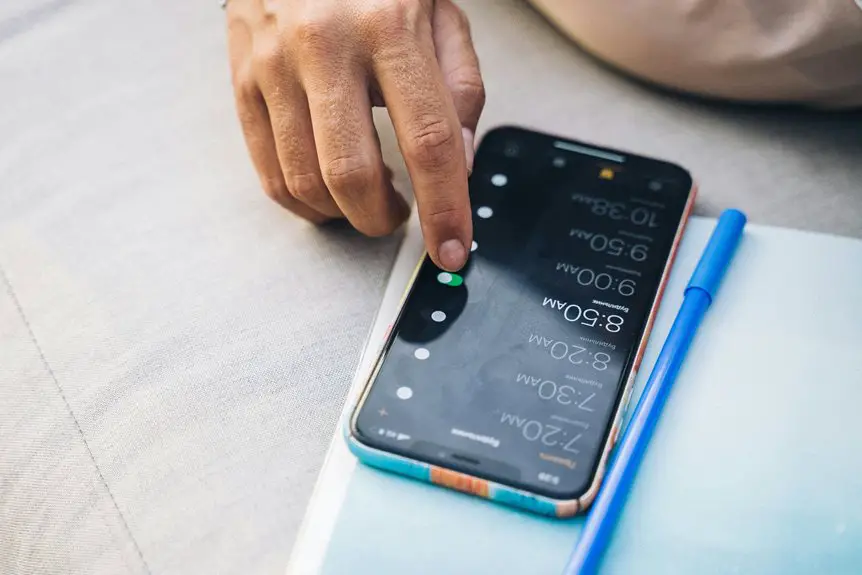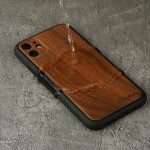You’ll find fabric phone cases offer stylish grip and decent shock absorption, especially with reinforced edges that cushion everyday drops. They protect well against scratches and moderate impacts but may wear out faster than silicone or plastic options. Fabric cases don’t fully absorb heavy shocks, so pairing one with a screen protector is wise. If you want to understand how fabric cases perform under pressure and whether they suit your protection needs, there’s more to explore.
Table of Contents
Key Takeaways
- Fabric phone cases provide moderate shock absorption by cushioning impacts better than bare phones, especially in moderate height drops.
- The soft fabric layer helps distribute force, reducing localized pressure and minimizing minor dents on the phone.
- Fabric cases maintain integrity without tearing in drops but may show stitching wear, impacting long-term durability.
- Compared to silicone and plastic, fabric cases offer better grip and scratch resistance but less effective shock protection.
- For enhanced safety, choose fabric cases with reinforced corners and consider pairing with a tempered glass screen protector.
Understanding Fabric Phone Cases
Fabric phone cases combine style and protection by using textile materials instead of traditional plastic or silicone.
When you choose a fabric case, you’re opting for a unique look that often feels softer and more comfortable in your hand. These cases still provide a layer of defense against scratches and minor impacts, thanks to the fabric’s natural cushioning abilities.
Fabric cases offer a unique, soft feel while protecting your phone from scratches and minor bumps.
You’ll find that fabric grips better, reducing the chance of accidental drops. Plus, fabric cases often feature reinforced edges or inner layers to boost protection without sacrificing aesthetics.
While they mightn’t be as rigid as hard plastic, they balance flexibility and shock absorption. Understanding how fabric cases function helps you decide if they fit your lifestyle and protection needs perfectly.
Types of Fabric Materials Used in Phone Cases
You’ll find fabric phone cases made from materials like cotton, wool, and polyester, each offering a unique feel.
These fabrics not only affect the case’s durability but also its texture in your hand.
Choosing the right material helps you balance style with protection.
Common Fabric Types
Although phone cases come in many materials, those made with textiles offer a unique blend of style and protection.
When choosing a fabric phone case, you’ll often encounter cotton, polyester, and nylon. Cotton cases provide a soft, natural feel and are breathable, but they might absorb moisture.
Polyester is popular for its durability and resistance to wrinkles and shrinking, making it a practical choice.
Nylon cases stand out for their strength and water resistance, giving you extra peace of mind.
You might also find cases with blends like cotton-polyester, combining softness and durability.
Some premium options use materials like felt or canvas, adding texture and visual appeal.
Knowing these common fabric types helps you pick a case that fits both your lifestyle and phone safety needs.
Durability and Texture
When selecting a phone case, understanding how different materials hold up to daily wear is essential. Each fabric type offers unique durability and texture, affecting how your phone feels and protects. For example, canvas provides a rugged texture with high durability, while microfiber feels soft but can wear faster. Wool blends offer warmth and a unique texture but may absorb moisture. Polyester cases often resist stains and water, maintaining their look longer. Here’s a quick comparison:
| Fabric Type | Durability & Texture |
|---|---|
| Canvas | Durable, rough texture, scratch-resistant |
| Microfiber | Soft, smooth, less resistant to wear |
| Wool Blend | Warm, textured, absorbs moisture |
| Polyester | Water-resistant, smooth texture |
| Denim | Sturdy, textured, fades over time |
Choose based on your lifestyle and feel preference.
Design Features That Enhance Protection
You want your phone case to do more than just look good—it needs to protect your device.
That’s why reinforced edges and corners are essential, as they absorb impact where your phone is most vulnerable.
Pair that with shock-absorbing materials, and you’ve got a case that guards against everyday drops and bumps.
Reinforced Edges and Corners
Reinforced edges and corners play an essential role in protecting your phone from drops and impacts. When your phone falls, these areas often take the brunt of the force.
Fabric cases with reinforced edges provide an extra layer of defense by strengthening these vulnerable points. This design helps prevent cracks and dents by distributing impact energy away from the phone’s body.
You’ll notice some cases feature thicker stitching or additional padding around the corners, which enhances durability without compromising the slim profile.
Shock-Absorbing Materials
Although fabric cases already offer a stylish look, their true strength lies in the shock-absorbing materials integrated into their design. These materials cushion your phone during drops and impacts, reducing damage risk. You’ll find various combinations, often hidden beneath the fabric exterior, working together to protect your device effectively.
| Material | Protection Benefit |
|---|---|
| TPU (Thermoplastic Polyurethane) | Flexible, absorbs shock well |
| EVA Foam | Lightweight, disperses impact |
| Silicone | Soft, prevents scratches |
| Memory Foam | Molds around phone for snug fit |
Choosing a fabric case with these materials guarantees your phone gets both style and reliable drop protection.
Setup and Parameters of the Drop Test
Before we plunge into the results, it’s important to understand how the drop test was set up and what parameters were used.
You’ll want to know the height from which the phone was dropped—set at 4 feet, simulating a typical pocket or hand drop. The phone was positioned face down, edge, and back down in separate drops to assess protection in various impact scenarios.
Each drop was performed on a hard concrete surface to mimic real-world conditions. We used the same phone model with a fabric case installed, ensuring consistency.
The phone’s functionality and physical condition were checked before and after each drop. This methodical approach helps you trust the validity and relevance of the upcoming findings.
Results From the First Drop Test
You’ll notice how well the fabric case absorbs impact during the first drop test.
The material’s durability also plays a big role in protecting your phone from scratches and dents.
Let’s take a closer look at how it held up under pressure.
Impact Absorption Performance
When you drop your phone, the case’s ability to absorb impact can make all the difference between a cracked screen and no damage at all.
In the first drop test, fabric cases showed decent shock absorption, cushioning the blow better than bare phones. The soft fabric layer helped distribute force across the case, reducing localized pressure on the phone.
However, while they absorbed impacts well from moderate heights, extreme drops still transmitted enough force to cause minor dents.
You’ll appreciate that fabric cases generally offer a balance—providing enough padding to protect against everyday slips without adding bulk.
Still, if you’re prone to frequent or severe drops, relying solely on fabric’s impact absorption mightn’t be enough to fully safeguard your device.
Case Material Durability
While fabric cases absorb moderate impacts well, their durability under repeated stress is just as important to evaluate.
In our first drop test, you’ll notice that the fabric maintained its integrity without tearing or fraying, which is a good sign for long-term use. However, the stitching around the edges showed slight wear, suggesting that constant drops or rough handling might eventually compromise the case’s protective ability.
You should also be aware that fabric can trap dirt and oils, potentially weakening the material over time. Compared to rigid plastic or silicone cases, fabric offers a softer feel but requires more care.
Performance in Multiple Drop Scenarios
Although fabric phone cases offer a stylish look, their performance in multiple drop scenarios can vary considerably.
When you drop your phone more than once, the case’s ability to absorb shock repeatedly becomes vital. Fabric cases often cushion initial impacts well but may show wear or lose cushioning after several drops. You might notice fraying or loosening stitches that reduce protection over time.
Additionally, some fabric cases have reinforced corners or padded layers that help maintain durability during repeated falls. However, if the fabric or inner padding degrades, your phone becomes more vulnerable.
To keep your device safe, it’s essential to check the case regularly for damage after multiple drops and consider replacing it if you spot significant wear or decreased shock absorption.
Comparing Fabric Cases With Silicone and Plastic Cases
Since you’re choosing a phone case, it’s important to understand how fabric cases stack up against silicone and plastic options.
Fabric cases offer a unique blend of style and grip, often feeling softer and more comfortable in your hand. However, they may not absorb shocks as well as silicone, which excels at cushioning impacts thanks to its flexible, rubbery texture.
Plastic cases, on the other hand, provide rigid protection but can be prone to cracking upon hard drops. Fabric cases can resist scratches and scuffs better than plastic but might wear out faster with daily use.
Ultimately, if you prioritize a balance of aesthetics and moderate protection, fabric cases work well, but for maximum shock absorption, silicone cases usually outperform both fabric and plastic.
Impact on Phone Functionality After Drops
If you drop your phone, the case you choose can directly affect how well your device functions afterward. Fabric cases often provide decent shock absorption due to their layered construction, which helps minimize internal damage.
However, unlike more rigid materials, fabric mightn’t prevent screen cracks if the impact is severe. After a drop, check your phone’s responsiveness—test the touchscreen, buttons, and charging port. Fabric cases generally don’t interfere with these functions, but if the phone sustained internal damage, you might notice lag or unresponsive features.
Also, be mindful that fabric cases can absorb moisture or dirt during drops, potentially affecting your phone’s ports or speakers over time.
Advantages and Disadvantages of Fabric Cases
When you choose a fabric phone case, you get a blend of style and comfort that hard plastic or metal can’t match. Fabric cases offer a soft, textured grip that feels great in your hand, reducing the chance of accidental drops. They also come in various patterns and colors, letting you express your personality.
However, fabric cases aren’t perfect. They tend to absorb dirt and stains more easily, requiring regular cleaning to keep them looking fresh. Plus, while they provide decent scratch protection, they may not offer the same level of shock absorption as thicker, rigid cases.
Fabric can wear down over time, especially at corners and edges. So, while fabric cases excel in aesthetics and comfort, you should weigh these benefits against potential durability concerns.
Recommendations Based on Drop Test Findings
Although fabric phone cases offer style and comfort, drop test results reveal important insights you should consider before making a choice. Fabric cases tend to absorb shock less effectively than silicone or rugged options. To protect your phone, look for fabric cases with reinforced corners or added padding. Avoid cases with thin fabric layers, as they provide minimal impact resistance. If you prioritize style, combine a fabric case with a tempered glass screen protector for thorough safety. Here’s a quick guide to help you decide:
| Feature | Fabric Case Pros | Fabric Case Cons |
|---|---|---|
| Shock Absorption | Moderate with padding | Poor without reinforced edges |
| Style | Stylish and unique | May wear out faster |
| Protection | Good for light drops | Not ideal for heavy impacts |
Frequently Asked Questions
How Do Fabric Phone Cases Affect Wireless Charging Capability?
You’ll find most fabric phone cases won’t interfere with wireless charging. Since fabric is thin and non-metallic, your charger can still connect effectively. Just avoid cases with thick padding or metal accents that might block the signal.
Are Fabric Phone Cases Easy to Clean and Maintain?
Like maintaining a classic novel’s pages, you’ll find fabric phone cases need gentle care. You can spot-clean them easily, but avoid harsh detergents; with a little effort, they stay fresh and stylish without losing charm.
Do Fabric Cases Cause Overheating During Extended Phone Use?
You won’t usually experience overheating with fabric cases since they allow better airflow than plastic or rubber. Just make sure your phone isn’t exposed to direct heat for too long, and you should be fine during extended use.
Can Fabric Cases Trigger Allergies or Skin Irritation?
You might experience allergies or skin irritation from fabric phone cases if you’re sensitive to certain materials or dyes. It’s smart to check the case’s fabric content and test it briefly on your skin before long use.
Are Fabric Phone Cases Environmentally Friendly or Biodegradable?
Think of fabric phone cases as a gentle breeze in a polluted city—they often use natural fibers, making them more eco-friendly and sometimes biodegradable. You’ll reduce plastic waste, but always check materials to be sure they’re truly sustainable.







